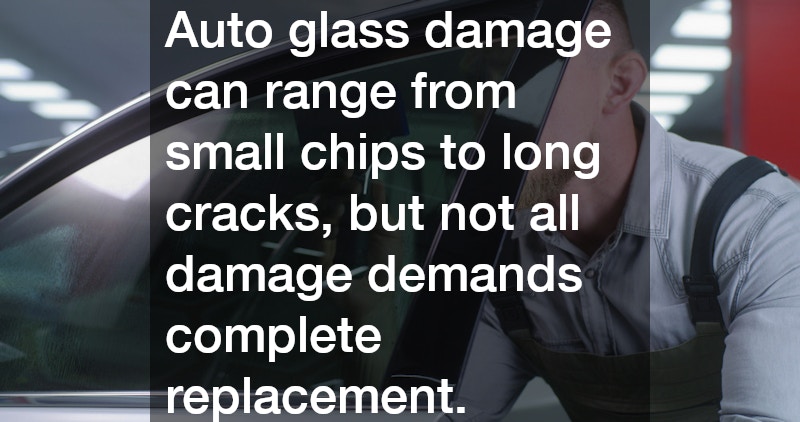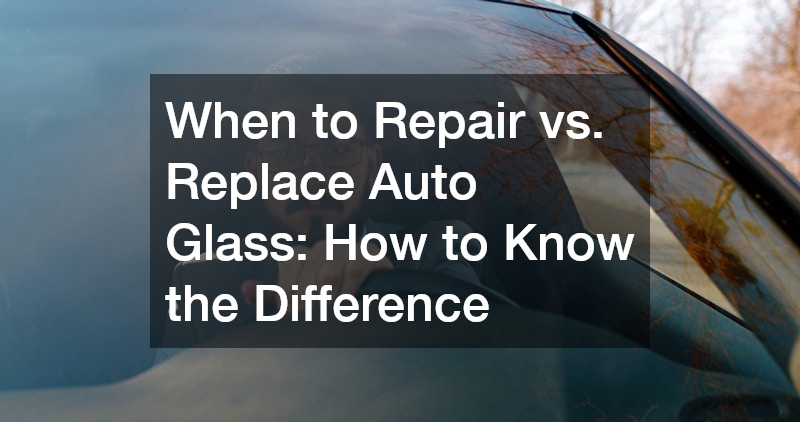
When to Repair vs. Replace Auto Glass: How to Know the Difference
Understanding the difference between when to repair and when to replace auto glass can save time and money and ensure safety. This article explores the essential factors to consider when deciding between auto glass repair and replacement.
What are the Signs that Auto Glass Needs Repair?
Types of Damage Suitable for Repair
Auto glass damage can range from small chips to long cracks, but not all damage demands complete replacement. Generally, chips smaller than a quarter or cracks less than a few inches long are good candidates for repair, especially if they don’t reach the edges of the glass.
The location of the damage significantly affects the decision, as chips and cracks directly in the driver’s line of sight might still necessitate replacement for safety reasons. Additionally, damage that hasn’t penetrated through multiple layers of the glass is often repairable.
It’s crucial to address minor damage quickly to prevent it from expanding. Weather conditions, vibrations, and time can contribute to exacerbating small defects into more significant, costlier issues.
Benefits of Repairing Auto Glass
Auto glass repair is typically a more cost-effective solution than total replacement. Quick repairs not only save money but also reduce vehicle downtime, allowing you to return to the road promptly.
Repairing auto glass is an eco-friendly option since it preserves more material than replacement, reducing waste. Additionally, maintaining the original factory seal with repairs often ensures the continued integrity of the windshield structure.
Fast repairs improve visibility and safety, preventing further damage and maintaining the structural integrity of the vehicle. A common benefit is that many repair techniques can be completed in under an hour, offering convenience for drivers with busy schedules.
When is it Necessary to Replace Auto Glass?
Extensive Damage and Safety Concerns
Extensive damage, such as cracks longer than a foot, often requires full replacement of the auto glass. Large cracks or multiple chips undermine the structural support that the windshield provides, leading to safety hazards in collisions.
Delaying replacement in the face of such extensive damage can pose significant safety risks, especially in a collision scenario where windshield integrity is crucial. Furthermore, replacement is imperative if the inner layer of glass is compromised, creating potential visibility issues.
Beyond safety, a fully compromised windshield can detract from the aesthetic and resale value of the vehicle. A strong windshield is essential in maintaining the car’s overall structural integrity, and replacement ensures that this support is restored.
Legal and Inspection Requirements
Auto glass must meet specific safety standards, and sometimes, repairable damage might still not pass a vehicle inspection. Many jurisdictions have legal requirements for the condition of auto glass that might necessitate replacement to remain compliant.
Often, regulations are strict about chips or cracks within the driver’s line of sight, regardless of their size, due to visibility concerns that affect overall driving safety. Insurance policies may also stipulate glass replacement under certain conditions to ensure comprehensive coverage.
These legal and inspection requirements underscore the importance of understanding local regulations and consulting with professionals to meet official standards. Adhering to these guidelines is integral to avoiding fines or penalties that can arise from non-compliance.
How to Choose Between Repair and Replacement?
Cost and Insurance Considerations
Both repair and replacement come with distinct cost implications that merit careful consideration. Glass repair is usually cheaper than replacement, but various factors, such as the size and location of the damage, may influence the final cost.
Insurance coverage can play a significant role in your decision, as many policies cover full repair costs, whereas replacement may involve a deductible. It is vital to check the specifics of your insurance to understand what is financially more beneficial.
By weighing cost differences alongside potential financial support from insurance, vehicle owners can make informed decisions. Prioritizing both budget and safety will yield the best outcomes when dealing with auto glass damage.
Consulting Professionals
Consulting with certified auto glass specialists is critical in making a well-informed decision. Professionals have the expertise to assess the extent of the damage accurately and recommend the best course of action based on safety and structural factors.
Obtaining multiple quotes and opinions can provide a broader perspective on available options and prices. This professional guidance can help you navigate decisions with confidence, ensuring that the choice between repair and replacement is based on credible insight.
Ultimately, professionals ensure that any auto glass work is completed to high standards, supporting long-term vehicle safety and performance. Their expertise not only helps address present issues but also assists in preventative maintenance strategies for the future.
Conclusion
Determining whether to repair or replace auto glass hinges on a variety of crucial factors, including the extent and location of the damage and safety considerations. By understanding the benefits of each option and incorporating professional advice, vehicle owners can make informed decisions.
Prioritizing safety, adherence to legal requirements, and cost-effectiveness can guide the choice, ensuring both short and long-term advantages. Quick action and consultation with auto glass experts are vital steps in maintaining optimal vehicle performance and safety.


